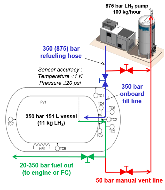Rapid high density cryogenic pressure vessel filling to 345 bar with a liquid hydrogen pump
- Lawrence Livermore National Lab. (LLNL), Livermore, CA (United States)
Cryogenic pressurized hydrogen (H2) vessels promise maximum storage density with potential to enabling practical H2 vehicles with maximum driving autonomy and minimum cost of ownership. This paper adds a more complete evaluation of the benefits of cryogenic vessel technology by establishing a methodology for evaluating fill density for any initial vessel thermodynamic state. This is accomplished by assessing 24 cryogenic pressure vessel fill experiments with a liquid hydrogen (LH2) pump manufactured by Linde and installed at the Lawrence Livermore National Laboratory (Livermore, CA) campus. The LH2 piston pump takes LH2 from the station Dewar at near ambient pressure (3 bar) and very low temperature (24.6 K) and pressurizes it to the vessel pressure in two stages of compression, up to 875 bar, although the rating of the cryogenic vessel used for these experiments limits fill pressure to 345 bar. Experiments spanned initial vessel temperatures from ambient to 22 K, enabling pump testing over a broad range of conditions. Experimental results validate many of the virtues that make LH2 pumping a promising technology for H2 dispensing, both for filling cryogenic as well as ambient temperature vessels: high throughput (1.67 kg/min, 100 kg/h), unlimited capacity for back to back refueling, low electricity consumption at the station due to high density of LH2 minimizing compression work, and highest fill density, up to 80 g/L (estimated) when dispensing cryogenic hydrogen at 700 + bar. Analysis of the experiments shows that fill density can be predicted with reasonable accuracy (±0.7 g/L) by assuming 10 kJ/kg K cryogenic vessel inlet entropy (pump delivery hose outlet entropy). Fill lines are finally generated on a H2 phase diagram, producing charts that can be used for rapidly determining fill density for any vessel condition at the moment of fill initiation.
- Research Organization:
- Lawrence Livermore National Lab. (LLNL), Livermore, CA (United States)
- Sponsoring Organization:
- USDOE Office of Energy Efficiency and Renewable Energy (EERE), Sustainable Transportation Office. Hydrogen Fuel Cell Technologies Office
- Grant/Contract Number:
- AC52-07NA27344; AC52- 07NA27344
- OSTI ID:
- 1558335
- Alternate ID(s):
- OSTI ID: 1636402
- Report Number(s):
- LLNL-JRNL-746862; 931685
- Journal Information:
- International Journal of Hydrogen Energy, Vol. 43, Issue 42; ISSN 0360-3199
- Publisher:
- ElsevierCopyright Statement
- Country of Publication:
- United States
- Language:
- English
Web of Science
Similar Records
Boil-off losses along LH2 pathway
The cold high-pressure approach to hydrogen delivery















